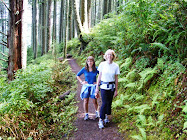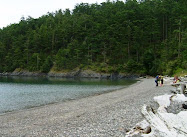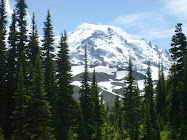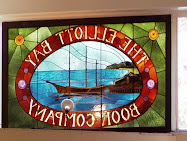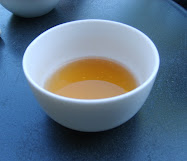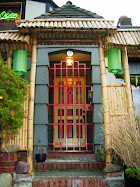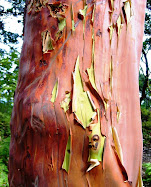However, if you make this trek in the fall and winter when the East Wind is blowing hard and cold through the Gorge, be careful of ice coating the trail near the base of the upper fall. It's very slick.
On just such a day recently, I drive east up Interstate 84 along the Columbia River to Multnomah Falls. Originally I wanted to hike Angel's Rest, but with a late start there isn't enough time and daylight left in the day.
Even on a chilly November weekday afternoon, there are tourists/sightseers taking photos and walking the trails around the falls. I guess that includes me, too.
Today I bypass the historic Multnomah Falls Lodge, where you can get a meal or cup of hot cocoa and enjoy the museum on the bottom level. My goal is exercise and the bracing thrill of the falls.
To reach the viewing platform above the upper fall, it's about 1.2 miles of paved trail up a little over 600 feet (for context, that's comparable to the height of Seattle's Space Needle). After the easy stroll up a couple switchbacks to the Benson Bridge above the lower fall, it's a dozen relentless switchbacks up to the top.
I start by meandering up the path to the bridge, stopping along the way for photos as water from the falls roils upward in a misty spray.
 |
| Lower Multnomah Fall, Benson Bridge |
 |
| Base of the upper fall |
As soon as I pass the bridge and start up, things get wintery quickly. Tubular chunks of ice lie on the trail beneath some of the branches, and the railing is coated in ice. My camera lense gets muddy when I hug the steep slope along the trail to avoid slipping on the icy asphalt.
After I hit the second switchback, the trail is so slick that I decide to abort...until two guys come down and say the trail dries out just a few feet beyond.
I'm so glad I continue. Indeed the trail dries out and angles away from the falls towards the river. A few pass me on the way down, but I have the trail to myself for most of the way up, with occasional marvelous views of the white-capped river below.
Lest you lose count of the switchbacks, there are signs at every turn indicating your progress ( 7 out of 11, 8 out of 11...). I top out at the ridge above the falls and then drop down a couple more switchbacks to the viewing platform perched just above the lip of the waterfall, where it plunges 500 feet.
 | ||
| It's a long way down! |
On the way down I stop and savor the views in the waning afternoon light. And tread extra carefully when I hit the last two switchbacks before the bridge.
Any time of year, but especially during the chilly season, a hike at Multnomah Falls, and perhaps looping over to Wahkeena Falls, is exhilarating. I'm always drawn to the Gorge and its fabulous waterfalls whenever I return to Oregon. How about you?
Thanks for visiting Pacific Northwest Seasons. I'd love to hear your comments below about this hike or others in the Gorge.
Happy trails!
When You Go
On a warm spring/summer/fall weekend, Multnomah Falls is best avoided except very early in the day (think crowds). In the winter, sometimes the trail to the top is closed due to icy conditions, so check the Columbia River Gorge National Scenic Area website before heading there. You'll pass through several microclimates as you weave near the falls and then away towards the river, so come prepared for changing conditions.
From Portland take I-84 eastbound for approximately 30 miles. Follow signs and take exit 31 (an unusual left-side exit ramp) to a parking area. Follow the path under the highway to reach the falls viewing area. For a more scenic trip, take I-84 eastbound to the Troutdale exit. Follow signs for the Scenic Loop drive, then follow the loop up to Corbett and down along the old Columbia River Highway (a National Historic Landmark) to Crown Point and ultimately the Multnomah Falls parking area.


















































